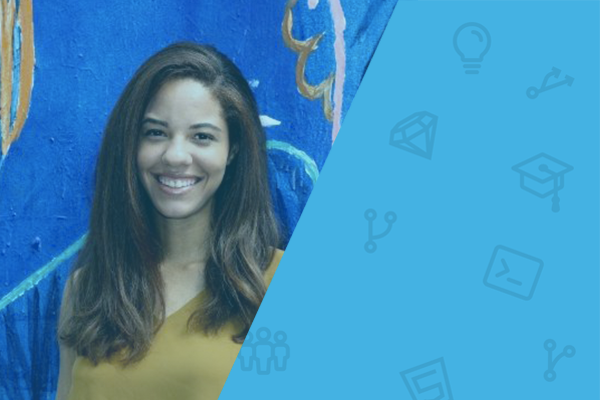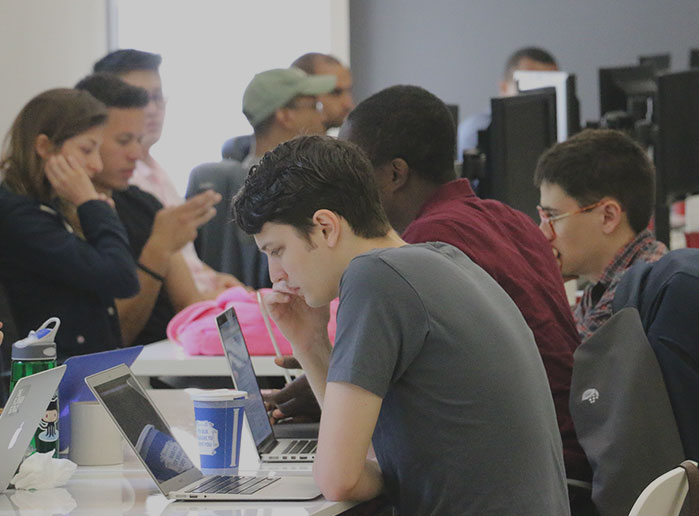In our Beyond the Bootcamp series, we chat with members of our alumni community about their post-Flatiron career journeys. What new roles have they taken on? How did they get to where they are now? What advice do they have for new programmers following in their footsteps?
Before Flatiron School, Simone Hill worked as an assistant editor at The Knot, “writing about all things weddings,” as she says. She’s now leveraging her creative instincts in another way: as a front-end engineer at Vogue.
Learning to Code
While working as assistant editor at The Knot, Simone realized what she really loved about her job was the tech product and the platform – a tool that brides and couples could use to plan their weddings. But, according to Simone, “I didn’t know anything about how it was created or what would go into building something like that. So I had no technical background, but I really wanted to immerse myself in that and learn to build those things so I could have a skill that I could use to create tools, platforms, and apps like that myself.”
More than learning the technical content, Simone says the challenge was overcoming the scary feeling of diving into something completely different. That said, she quickly began to see parallels between writing and coding: “You have to construct an argument when you write any piece of content and really think through the flow of how a reader consumes it. You have to put yourself in that position a lot of times when you’re thinking through building a feature as an engineer because you have to consider: what’s that first interaction point? How do you get from that first interaction point and create the experience that the user expects? Or sometimes you want to create something that they don’t expect!”
The Flatiron School Experience
What Simone was seeking in a coding bootcamp wasn’t so different from what she wanted out of her undergraduate education. “I really enjoy the liberal arts experience in broadening problem solving skills as opposed to teaching someone a very specific tool,” she says. “I think one of the big critiques of a lot of bootcamps is that when this technology changes in five years, you’ll be left behind.” That wasn’t the case for Simone at Flatiron School: “I learned problem solving skills that I still use as an engineer and built a great base through which to continue learning and teaching myself as well.”
For Simone, the best part of the experience was how students presented their projects to the technical community. “I hate public speaking to this day,” she says, “but it was a really great way to force me to articulate technical ideas in front of an audience, and I think that was a really big benefit to have, especially when you think about going into job interviews and things like that – it really prepares you for that kind of experience.”
Simone’s biggest revelation at Flatiron School was proving to herself that she could push through her self-doubt and tackle new things. “I always had this sense of myself that I’m not a technical person, I don’t come from a logical mindset – I studied anthropology, and I was a writer – that those things weren’t me,” she says. “But it wasn’t true. Anyone, including me, can push themselves to learn to code.”
Life at Vogue
Vogue hired Simone as a junior engineer. Following her passion for front-end challenges, she was promoted to front-end engineer. Still, according to Simone, working on a small team within the larger organization allows Simone to “see and interact with a lot of different pieces of our code base that’s not necessarily strictly front end. No one is pigeon-holed.” Plus, she notes that with the advent of React, what it means to be a front-end developer has changed drastically: “Being a front end engineer used to mean you’re just writing HTML and CSS. Now we have this thing called React, where you’re doing a lot of JavaScript logic in your view with your HTML, and there are some people that even bring CSS directly in there too, within React. I get to see and learn so much about the different pieces of our app.”
The biggest surprise Simone encountered after starting her career at Vogue: some of the bigger challenges actually come once you’ve already passed the initial hurdle of learning to code. “I think Avi, while I was at Flatiron,” she remembers, “he told us that quote: ‘Make it work, make it right, ten make it fast.’” Simone’s challenge now that she knows how to code is to keep learning, to absorb the wealth of information out there, find what’s actually important, and bring it into her everyday work – while balancing that with getting things done. “Making things work in the way that you know that they will work versus really researching and trying something new,” she explains.
What’s next for Simone?
Learning to code and being a software engineer was a very intentional step for Simone, and development isn’t exactly where she plans to end up. “Ultimately I want to transition into a product facing role, lead a product team at a startup, or product at any number of companies,” she explains. “I think what really hooked me into my desire to learn to code and my love of technology is working on a tool and thinking of features, creating this story of who the user is, and what they do, and how they interact with the site, and how we fulfill their need for them with a piece of technology. So my first step was to learn to code and be a software engineer because I really felt like I had the perspective from the creative side and the user side, but I didn’t have the understanding of how I would actually embark on building something.”
Ready to start your own programming journey? The best way to get started is our free Bootcamp Prep course. Stay tuned for more installments of “Beyond the Bootcamp”!
Written byJOSH HIRSHFELD
Content Marketing Manager, Flatiron School

